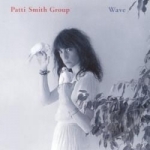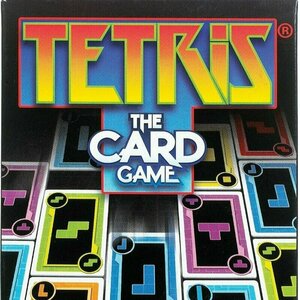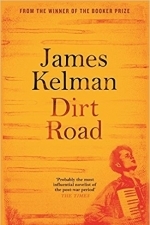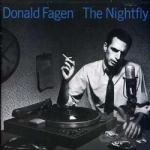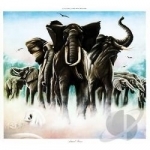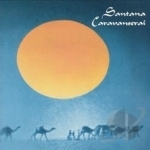Search
Search results
Brian Eno recommended Early Works by Steve Reich in Music (curated)
Shirley Manson recommended Wave by Patti Smith Group / Patti Smith in Music (curated)
Purple Phoenix Games (2266 KP) rated Tetris: The Card Game in Tabletop Games
Jul 2, 2020
One of the first video games I can remember playing is Tetris. The colorful Tetrominoes, the catchy theme music, the excitement (and anxiety!) as the speed gradually increases – what isn’t there to love? Tetris is an addicting game that has withstood the test of time, so I was extremely excited when I was gifted Tetris: The Card Game. Does the card version have a foothold in the Tetris fandom? Or does it fail to complete any rows in the matrix? (Haha, see what I did there?)
Tetris: The Card Game is a game of hand management and pattern recognition in which players are racing to be the first to earn 10 points. Setup is simple – shuffle the entire deck of cards, and deal 10 to each player. The cards are double-sided, with one side depicting a Tetris Matrix, and the other depicting a specific Tetromino. Arrange your cards in a 2×5 grid, with the Tetromino side facing up. This grid will act as your personal scoring track. Place the remaining cards, Matrix-side up, in a draw deck in the center of the table. Deal 1 additional card to each player, to go in hand, and the game is ready to begin! You will be using your hand of cards, Tetromino side, to complete the Matrix side of the top card of the draw deck.
A round of play is pretty straight-forward: draw one card, play one card. At the start of your turn, draw the top card from the draw deck. This will reveal a new Matrix on the next card of the draw pile. Choose one of your two cards in hand to complete at least 1 row in the revealed Matrix. Play the card, showing your opponents how it would fit into the Matrix, and score points. You score 1 point per row completed, so if your piece completes 2 rows, you would score 2 points. To track your points, you flip over cards in your 2×5 grid to their Matrix sides, to represent your scored points. If on your turn, you are unable to complete a Matrix line with either of your cards in hand, you must discard one card, and are also penalized by having to forfeit one of your earned points, flipping that card back to its Tetromino side. There are also a handful of Special cards that can be used to manipulate play, whether Reversing the play direction, or forcing a player to lose a point, and that adds a new little twist to the game. The game ends when one player has scored all 10 points and is declared the winner!
Probably the best things about Tetris: The Card Game, is that it is so simple to learn and play. The simplicity brings back the nostalgia of the original game to the extreme. It’s a super light game that can be used as a filler/palate cleanser between bigger games, or just as a game to toss on the table when you’ve got 5 free minutes. Another added bonus of its simplicity is that it is pretty friendly for younger/newer gamers. Looking to get your young’uns into the hobby, or just spreading some happiness with friends and colleagues? This is a good introductory game that is light-hearted, although not a complete brain burner.
Now, on the flip side, there are some drawbacks to this game. The first and biggest being that it is entirely based upon the luck of the draw. There is pretty much no strategy involved, because you are at the mercy of the draw deck. You really can’t set up a game strategy that can be adapted throughout a play because the game is so dependent upon luck. Depending on the current Matrix in play, certain Tetrominos could not be used at all to complete a row, so you end up having to burn a turn (and losing a point) to discard a card. And then you have to hope for the best next turn. Another drawback of this version of Tetris is the hand limit of 2 cards. That severely limits your options each turn, and can turn the game from light-hearted to frustrating because of a lack of choices. This hand limit also limits any strategic options. Certain Matrices can only be completed by certain Tetrominos, so unless you have those in hand, you’re stuck wasting a turn. The Special cards included in the game add a twist to the gameplay, but are a little too ‘take that’ for my taste. But without them, there is no player interaction at all. So it’s kind of a lose-lose situation for me in that regard.
Ultimately, I would say that the OG Tetris is still king. This game attempts to encompass the atmosphere and enjoyability of the video game, but it just falls flat for me. It is too dependent upon luck, and doesn’t offer enough strategic choices for players, so it ends up feeling bland and unengaging. Am I happy with this game? Honestly, no. But playing this with the right group of people could still result in some entertainment and good times. If luck-based games are your thing, then definitely consider this game. But if not, let OG Tetris be your go-to game to fulfill your tile-dropping, row-completing urges. Purple Phoenix Games gives Tetris: The Card Game a blocky 4 / 12.
Tetris: The Card Game is a game of hand management and pattern recognition in which players are racing to be the first to earn 10 points. Setup is simple – shuffle the entire deck of cards, and deal 10 to each player. The cards are double-sided, with one side depicting a Tetris Matrix, and the other depicting a specific Tetromino. Arrange your cards in a 2×5 grid, with the Tetromino side facing up. This grid will act as your personal scoring track. Place the remaining cards, Matrix-side up, in a draw deck in the center of the table. Deal 1 additional card to each player, to go in hand, and the game is ready to begin! You will be using your hand of cards, Tetromino side, to complete the Matrix side of the top card of the draw deck.
A round of play is pretty straight-forward: draw one card, play one card. At the start of your turn, draw the top card from the draw deck. This will reveal a new Matrix on the next card of the draw pile. Choose one of your two cards in hand to complete at least 1 row in the revealed Matrix. Play the card, showing your opponents how it would fit into the Matrix, and score points. You score 1 point per row completed, so if your piece completes 2 rows, you would score 2 points. To track your points, you flip over cards in your 2×5 grid to their Matrix sides, to represent your scored points. If on your turn, you are unable to complete a Matrix line with either of your cards in hand, you must discard one card, and are also penalized by having to forfeit one of your earned points, flipping that card back to its Tetromino side. There are also a handful of Special cards that can be used to manipulate play, whether Reversing the play direction, or forcing a player to lose a point, and that adds a new little twist to the game. The game ends when one player has scored all 10 points and is declared the winner!
Probably the best things about Tetris: The Card Game, is that it is so simple to learn and play. The simplicity brings back the nostalgia of the original game to the extreme. It’s a super light game that can be used as a filler/palate cleanser between bigger games, or just as a game to toss on the table when you’ve got 5 free minutes. Another added bonus of its simplicity is that it is pretty friendly for younger/newer gamers. Looking to get your young’uns into the hobby, or just spreading some happiness with friends and colleagues? This is a good introductory game that is light-hearted, although not a complete brain burner.
Now, on the flip side, there are some drawbacks to this game. The first and biggest being that it is entirely based upon the luck of the draw. There is pretty much no strategy involved, because you are at the mercy of the draw deck. You really can’t set up a game strategy that can be adapted throughout a play because the game is so dependent upon luck. Depending on the current Matrix in play, certain Tetrominos could not be used at all to complete a row, so you end up having to burn a turn (and losing a point) to discard a card. And then you have to hope for the best next turn. Another drawback of this version of Tetris is the hand limit of 2 cards. That severely limits your options each turn, and can turn the game from light-hearted to frustrating because of a lack of choices. This hand limit also limits any strategic options. Certain Matrices can only be completed by certain Tetrominos, so unless you have those in hand, you’re stuck wasting a turn. The Special cards included in the game add a twist to the gameplay, but are a little too ‘take that’ for my taste. But without them, there is no player interaction at all. So it’s kind of a lose-lose situation for me in that regard.
Ultimately, I would say that the OG Tetris is still king. This game attempts to encompass the atmosphere and enjoyability of the video game, but it just falls flat for me. It is too dependent upon luck, and doesn’t offer enough strategic choices for players, so it ends up feeling bland and unengaging. Am I happy with this game? Honestly, no. But playing this with the right group of people could still result in some entertainment and good times. If luck-based games are your thing, then definitely consider this game. But if not, let OG Tetris be your go-to game to fulfill your tile-dropping, row-completing urges. Purple Phoenix Games gives Tetris: The Card Game a blocky 4 / 12.
Eilidh G Clark (177 KP) rated Dirt Road in Books
May 13, 2017
Kelman is an expert in understanding people
Kelman’s new novel Dirt Road is story that takes both characters and reader on a journey right from the outset, but the journey is more than it seems. The novel begins in the West coast of Scotland where we learn that Murdo - a sixteen-year-old boy - and his father Tom are mourning the death of their mother/wife and sister/daughter. Searching for solace, they embark on a journey to Alabama, U.S.A to spend time with Uncle John and Aunt Maureen. For Murdo, family is just a happy memory, a moment in time captured in a photograph, ‘The family was four and not just him and Dad’, whilst for Tom, family is the bond that holds them together. Throughout the journey, Tom strives to guide his son and keep him on ‘the right path’, yet Murdo, as we will learn, has a path of his own to find. Stifled by the fathers influence, the boy has a tendency to stray, thus when they reach Allentown Mississippi, Murdo stumbles upon a family of musicians led by Zydeco performer Queen Monzee-ay. Murdo is as drawn to music as his father is to family, the boy himself is an accomplished accordion player, and when he is offered an opportunity to play a set with Queen Monzee-ay in two weeks’ time, we watch as the road between father and son diverges and choice and risk becomes the key plot in the story.
While this may appear a simple story line, Kelman’s exploration into the fragmented relationship between father and son gives the reader an honest analysis of family and grief. The third person narrator, with bursts of free indirect discourse from Murdo, allows the reader both an internal and external insight into the constraints of family. This parallel leaves the reader feeling uncomfortable, yet with a conflicting heart. This is Kelman’s unique writing style at its best.
Dirt Road is more than a novel of grief and family relationships though; it is a novel of risk, of following new paths with uncertainties, about leaving behind the familiarities and safety of the past and following the heart. It is about deep connections; for Murdo this is through music and the feeling of freedom that he associates with music, whilst for the other characters it is about cultural connections and Scottish ancestry. Kelman’s clever use of parallels shows the reader the intensity of human connections whilst suggesting that change and progression is possible. This great novel will linger in your thoughts for weeks after you put it down, and it brings to mind a poem by Robert Frost, The Road Not Taken
I shall be telling this with a sigh
Somewhere ages and ages hence:
Two roads diverged in a wood, and I—
I took the one less traveled by,
And that has made all the difference.
For the full poem visit (https://www.poetryfoundation.org).
Dirt Road by James Kelman
Canongate Books (14 July 2016)
While this may appear a simple story line, Kelman’s exploration into the fragmented relationship between father and son gives the reader an honest analysis of family and grief. The third person narrator, with bursts of free indirect discourse from Murdo, allows the reader both an internal and external insight into the constraints of family. This parallel leaves the reader feeling uncomfortable, yet with a conflicting heart. This is Kelman’s unique writing style at its best.
Dirt Road is more than a novel of grief and family relationships though; it is a novel of risk, of following new paths with uncertainties, about leaving behind the familiarities and safety of the past and following the heart. It is about deep connections; for Murdo this is through music and the feeling of freedom that he associates with music, whilst for the other characters it is about cultural connections and Scottish ancestry. Kelman’s clever use of parallels shows the reader the intensity of human connections whilst suggesting that change and progression is possible. This great novel will linger in your thoughts for weeks after you put it down, and it brings to mind a poem by Robert Frost, The Road Not Taken
I shall be telling this with a sigh
Somewhere ages and ages hence:
Two roads diverged in a wood, and I—
I took the one less traveled by,
And that has made all the difference.
For the full poem visit (https://www.poetryfoundation.org).
Dirt Road by James Kelman
Canongate Books (14 July 2016)
Bong Mines Entertainment (15 KP) rated Wild Things - Single by Annprincess in Music
Jun 21, 2019
Annprincess is an up-and-coming singer-songwriter based in Oslo, Norway. Not too long ago, she released a dance video for her “Wild Things” single.
‘Wild Things’ contains a relatable storyline, pleasing vocals, and vibey instrumentation flavored with electro-pop and tropical-dance elements.
Also, the likable tune showcases Annprincess’ effortless gift for writing R&B-infused pop tunes.
Annprincess fled her home country of Liberia at the age of seven as a refugee. Shortly afterward, she and her mother found sanctuary in Norway, the place she now calls home.
At the time, Liberia had internal conflict and attempted coups were an everyday occurrence.
Also, Annprincess’ father, Prince Yormie Johnson, was one of the prominent figures in the first Liberian Civil War (1989-1997).
He became notorious for killing anyone who opposed his views or actions. And Annprincess’ mother was repeatedly jailed for her opposition to him.
Also, his role in the torture and murder of President Samuel Doe in 1990 is well documented on video, a part for which there is a regular talk of him being indicted for war crimes.
One of ten children to Prince Yormie’s multiple wives, Annprincess grew up with a dysfunctional view of relationships.
Even those closest to her, leading to her songwriting in which many of her lyrics deal with failed interactions between people.
Forever feeling she has been the underdog in life, Annprincess’ resilience sees her balancing two jobs alongside her music career, not to mention being a successful football player and coach.
Along with her mother, she has overcome every obstacle life has thrown at her and adapted to an alien culture and language.
Also, she used the negative experiences of her story to become an inspirational example to others to never give up in the pursuit of your dreams.
‘Wild Things’ contains a relatable storyline, pleasing vocals, and vibey instrumentation flavored with electro-pop and tropical-dance elements.
Also, the likable tune showcases Annprincess’ effortless gift for writing R&B-infused pop tunes.
Annprincess fled her home country of Liberia at the age of seven as a refugee. Shortly afterward, she and her mother found sanctuary in Norway, the place she now calls home.
At the time, Liberia had internal conflict and attempted coups were an everyday occurrence.
Also, Annprincess’ father, Prince Yormie Johnson, was one of the prominent figures in the first Liberian Civil War (1989-1997).
He became notorious for killing anyone who opposed his views or actions. And Annprincess’ mother was repeatedly jailed for her opposition to him.
Also, his role in the torture and murder of President Samuel Doe in 1990 is well documented on video, a part for which there is a regular talk of him being indicted for war crimes.
One of ten children to Prince Yormie’s multiple wives, Annprincess grew up with a dysfunctional view of relationships.
Even those closest to her, leading to her songwriting in which many of her lyrics deal with failed interactions between people.
Forever feeling she has been the underdog in life, Annprincess’ resilience sees her balancing two jobs alongside her music career, not to mention being a successful football player and coach.
Along with her mother, she has overcome every obstacle life has thrown at her and adapted to an alien culture and language.
Also, she used the negative experiences of her story to become an inspirational example to others to never give up in the pursuit of your dreams.
Dean (6927 KP) rated Mini Projector in Tech
Jan 23, 2020
Noisy (2 more)
Sound quality
Some ports didn't work?
Disappointing
Well this is a shame I got this through the giveaway competition. I've tried to give it a good test but it didn't fare well.
The good thing is the projection area can be very large and still fairly sharp in focus. It recommends up to 60" but could easily get closer to 80" TV screen size equivalent. Any bigger and the image wouldn't be as sharp or colourful but if you don't mind that it could take up a whole wall. The HDMi port works so you could connect it to your sky box, xbox, dvd player. The sound quality from it isn't great though as it's only a small device, unless you also connect a speaker. It can be a little noisy as well during operation.
Unfortunately the microSD card and USB ports don't appear to be working on this unit? I tried a couple of cards and a USB card reader but nothing worked. This would be handy for viewing photos. It also has an AV port for music. It does come with a remote, HDMi cable and an adapter that would work with a camcorder or even a Wii console.
The power cable isn't particularly long but once charged it can be used cordless. It doesn't really have a stand to help if you wanted to project onto your ceiling.
So it really depends what you are going to use it for. Plug your xbox in for wall size gaming, or your phone via HDMi to watch Netflix, YouTube etc. I don't think it's something you would use for serious movie watching if you care about the sound quality as well unless you connect headphones or a speaker as well via the phonejack.
The good thing is the projection area can be very large and still fairly sharp in focus. It recommends up to 60" but could easily get closer to 80" TV screen size equivalent. Any bigger and the image wouldn't be as sharp or colourful but if you don't mind that it could take up a whole wall. The HDMi port works so you could connect it to your sky box, xbox, dvd player. The sound quality from it isn't great though as it's only a small device, unless you also connect a speaker. It can be a little noisy as well during operation.
Unfortunately the microSD card and USB ports don't appear to be working on this unit? I tried a couple of cards and a USB card reader but nothing worked. This would be handy for viewing photos. It also has an AV port for music. It does come with a remote, HDMi cable and an adapter that would work with a camcorder or even a Wii console.
The power cable isn't particularly long but once charged it can be used cordless. It doesn't really have a stand to help if you wanted to project onto your ceiling.
So it really depends what you are going to use it for. Plug your xbox in for wall size gaming, or your phone via HDMi to watch Netflix, YouTube etc. I don't think it's something you would use for serious movie watching if you care about the sound quality as well unless you connect headphones or a speaker as well via the phonejack.
Thundercat recommended Nightfly by Donald Fagen in Music (curated)
Martin Carr recommended track Oliver's Army (with Elvis Costello & The Attractions) by Elvis Costello / Elvis Costello & The Attractions in Armed Forces by Elvis Costello / Elvis Costello & The Attractions in Music (curated)
Rat Scabies recommended Caravanserai by Santana in Music (curated)
Gareth von Kallenbach (980 KP) rated Girls Trip (2017) in Movies
Jul 11, 2019
The previews for “Girls Trip” are a bit deceiving. Like many comedies, the trailer only shows half jokes and makes the film look like it leans toward the slap stick side of comedy rather one filled with clever humor. The first few minutes feel a little forced in their attempt to make people laugh. But rather quickly that impression fades.
The audience rolled with laughter at the screening for “Girls Trip” for pretty much the entire length of the film. Perhaps the funniest comedy about a squad of misbehaving women since “Bridesmaid;” each moment comes at you fast and is funnier than the last.
Highschool friends Ryan (Regina Hall), Sasha (Queen Latifa), Lisa (Jada Pinkett Smith), and Dina (Tiffany Haddish) travel to New Orleans for a girls trip to reconnect and cut loose after years apart. Hot guys, loud music, and adults-only jokes, their trip is filled with mishaps. The comedic style is a little chaotic, but its so much fun to watch.
Also really enjoyable are the musical appearances by Ne-Yo, Mariah Carey, and Diddy. The plot is largely about the entertainment industry and its more human side.
“Girls Trip” also has a surprising amount of depth running through its storyline. The four ladies had grown apart and had their issues with each other here and there after high school. On the trip, years of misunderstandings surface to get hashed out. Strong themes of friendship, inner strength and honesty with oneself are a core part of the film.
Ryan herself has become a celebrity over the years alongside her famous football player husband, and Sasha has developed a tabloid website. The two women are diametrically opposed to each other at points. Their struggle for understanding gives viewers a glimpse of the effect the scorning public eye has on celebrities and their personal lives.
The audience rolled with laughter at the screening for “Girls Trip” for pretty much the entire length of the film. Perhaps the funniest comedy about a squad of misbehaving women since “Bridesmaid;” each moment comes at you fast and is funnier than the last.
Highschool friends Ryan (Regina Hall), Sasha (Queen Latifa), Lisa (Jada Pinkett Smith), and Dina (Tiffany Haddish) travel to New Orleans for a girls trip to reconnect and cut loose after years apart. Hot guys, loud music, and adults-only jokes, their trip is filled with mishaps. The comedic style is a little chaotic, but its so much fun to watch.
Also really enjoyable are the musical appearances by Ne-Yo, Mariah Carey, and Diddy. The plot is largely about the entertainment industry and its more human side.
“Girls Trip” also has a surprising amount of depth running through its storyline. The four ladies had grown apart and had their issues with each other here and there after high school. On the trip, years of misunderstandings surface to get hashed out. Strong themes of friendship, inner strength and honesty with oneself are a core part of the film.
Ryan herself has become a celebrity over the years alongside her famous football player husband, and Sasha has developed a tabloid website. The two women are diametrically opposed to each other at points. Their struggle for understanding gives viewers a glimpse of the effect the scorning public eye has on celebrities and their personal lives.

